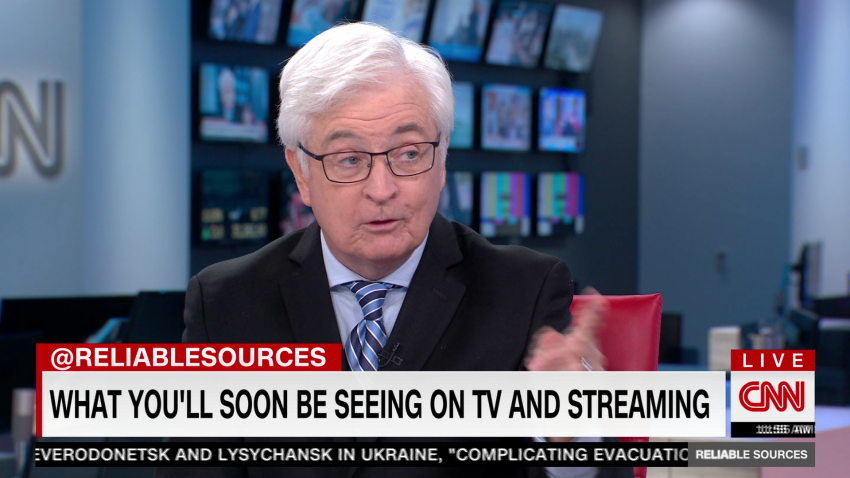Editor’s Note: Bill Carter, a media analyst for CNN, covered the television industry for The New York Times for 25 years, and has written four books on TV, including The Late Shift and The War for Late Night. The opinions expressed in this commentary are his own.

Streaming networks were the center of attention last month when the television industry — or, more accurately now, the entertainment industry — staged its annual ritual known as the “upfronts.”
Long-time attendees of these affairs surely felt some sense of disorientation, because the upfronts were invented as grandiose presentations by broadcast networks to unveil their upcoming wares for ad buyers.
But companies like Universal and Disney seemed to spend much more time talking about offerings like the latest Marvel marvel on Disney+ (“She-Hulk: Attorney at Law”) or the star-vehicle on Peacock (“Bupkis,” starring Pete Davidson and Edie Falco) than anything upcoming on the companies’ respective television networks, ABC and NBC.
The program distributors (what used to be called studios) are trying to navigate a marketplace that is not entirely sure where it’s going. Streaming was expected to take over as the be-all/end-all of not just TV, but also the film industry. But the sudden crash for Netflix, the industry leader, in both subscribers and stock price, has the business collectively hitting the pause button. After all, who knows whether an overall better idea than streaming is only a few years away?
At least some of the big bets on streaming are being hedged by the inclusion of ads, which may be smart, because it lessens a company’s dependence on subscriptions, and users already have a number of options to choose from. Being overly confident about the business of putting entertainment into American homes has led some businesses into dark places — just look at radio, and more recently, cable TV.
The pattern over the past century has revealed a continuum of sorts: hugely successful media giants dominating the entertainment scene, growing fat and cocky, dismissive of upstart competitors, followed by a humbling slide toward marginalization, if not outright irrelevance.
This continuum has played out in the entertainment business since the early 20th Century.
First radio was so dominant that surely no one thought television could ever replace it. Then broadcast TV was such an enormous presence in American life, some network executives dismissed cable TV as destined to be small-timey forever. (CBS regularly presented futuristic presentations that forecast little impact on the network business from cable.)
Cable once had what looked like the most potent business model of all: monopoly franchises in localities, which compelled consumers to pay for “bundles” of channels, some (or many) of which they didn’t even want.
Then the lame service many cable systems offered became fodder for jokes — and outrage. But what was ever going to come along to disrupt the happy cable party?
Enter Netflix, which initially got the same treatment: How many people would pay big monthly fees for a library of repeats? Or an original show here and there? But very quickly Netflix had the shows — and the model — not just to threaten cable, but to revolutionize TV viewing: a vast array of video offerings; TV series of much shorter duration than network fare; making every episode available at the same time for gorging at will, and without the pernicious interruption of commercials. A viewer could watch a whole series in a single day and never be bothered by somebody selling corn flakes.
Netflix, of course, is now the acknowledged occupant of the Iron Throne of stream-land. And yet, it’s already encountering the latest case of “uneasy lies the head that wears a crown.” In April, the company reported that it lost 200,000 subscribers in the first quarter of 2022, and that it expects to lose 2 million more in the second quarter. It lost $50 billion in market cap on the news.
There could be a number of reasons for the huge subscriber drop, but the biggest seems to be increased competition, with a slew of companies with great resources and deep libraries of content entering the streaming world in recent years, including Disney, Universal and Warner Bros. Discovery (the parent company of CNN).
And with so many streaming services now available, an awareness seems to be sinking in: Are people really going to pay 10 bucks a month or more indefinitely for an ever-increasing array of streamers?
Netflix’s subscriber loss could be a sign that they’re not. And it doesn’t help Netflix that its expenses are hugely high, mainly from the effort to keep grinding out talked-about TV shows and movies.
Now that it has seen potential financial holes in that bountiful bucket of profits it has been enjoying (or at least has recognized that the bucket has sprung a major leak), Netflix, following in the footsteps of streaming competitors like Hulu and HBO Max, is reportedly exploring a new option for financial security. Or rather an old one, a really old one.
The one that brought all those people together in Manhattan for the upfronts: ad dollars.
Netflix is reportedly expected to begin offering lower-priced subscriptions for a separate tier of programming that will include (perish the thought) commercials.
It’s probably a sensible strategy. After all, in one form or other, it’s worked before — for about a hundred years.























